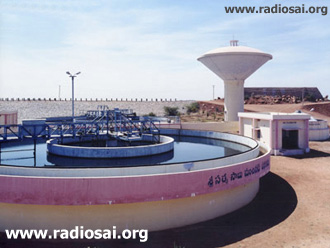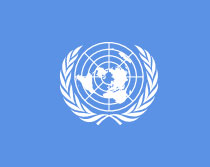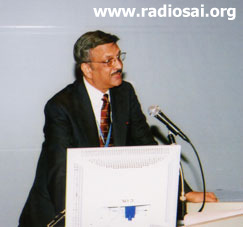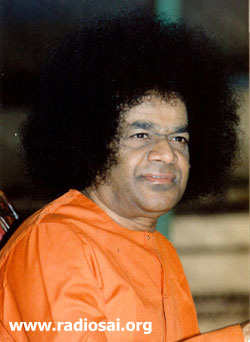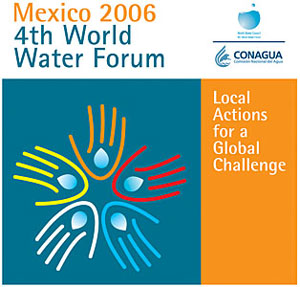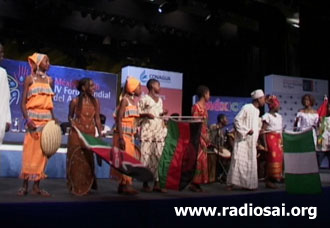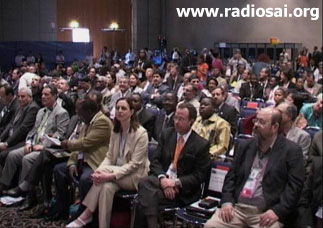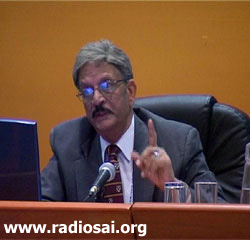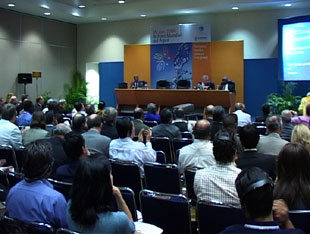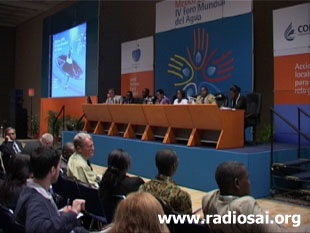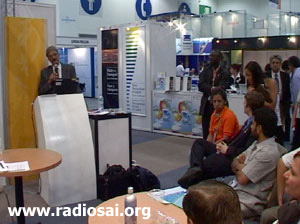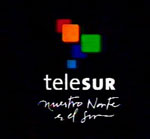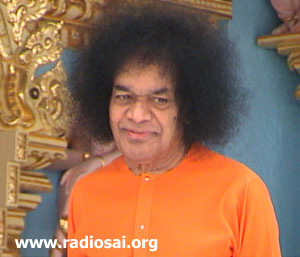 |
 |
 |
 |
| Volume 4 - Issue 06 JUNE 2006 |
|
THE FOURTH WORLD WATER FORUM LEARNS MUCH FROM THE SRI SATHYA SAI DRINKING WATER PROJECTS Introduction The Fourth World Water Forum (4WWF) was held recently in Mexico City from 16th - 22nd March 2006 on the theme of "Local Actions for a Global Challenge". The World Water Forum is the flagship summit of the World Water Council which was established in 1996 on the initiative of renowned water specialists and international organizations. Its mission is "to promote awareness, build political commitment and trigger action on critical water issues at all levels, including the highest decision-making level, to facilitate the efficient conservation, protection, development, planning, management and use of water in all its dimensions on an environmentally sustainable basis for the benefit of all life on earth."
Nearly 20,000 people converged in Mexico City from 140 countries to take part in the two hundred working sessions, during which 1,500 local actions were presented. The participants included official representatives, 78 ministers, 120 mayors, 150 legislators, 1,395 journalist experts, apart from many NGOs, and civil society representatives, etc. But why are we interested in the World Water Forum? Simply because the Forum is very interested and excited about Swami’s Water Mission.
To give you more details of what exactly went on in the forum, we have below an interview with Prof. Anantharaman who actually presented the case study of Swami’s Drinking Water Projects to the forum in Mexico City recently. Prof Anantharaman has worked as Managing Director of several multinational companies in Africa, Asia, Europe, USA and also as Chairman and Chief Executive Officer of a Transnational Business conglomerate based in Switzerland. He has served as an adjunct professor in several business schools including the Harvard Business School and is currently an honorary faculty member in the School of Business Management at Puttaparthi. In conversation with Prof. Anantharaman (AN) is Prof. G Venkataraman (GV), a former Vice Chancellor of Swami’s University. Over to the interview: Prof. G Venkataraman In Conversation With Prof. Anantharaman
AN: The WWF meets every three years. The third WWF was in Kyoto three years ago and during the time they met in Kyoto, and in the earlier water forum also, they developed certain Millennium Development Goals (MDGs) for availability of water to people all over the world. GV: Is the WWF by any chance a part of the United Nations, officially or unofficially? AN: It is an unofficial body of the United Nations. And UN – HABITAT had sponsored a special programme in both, the third WWF and in the fourth WWF, to concentrate on Millennium Development Goals.
GV: How did they come to hear about the Anantapur Project at all? Because even here some people don’t know about it. AN: I think UN-HABITAT, which was one of the co-sponsors of this WWF, have heard about our Anantapur project. In fact they had come and visited us here. UN-HABITAT had even asked the Housing and Urban Development Corporation of Delhi (HUDCO) to do an impact evaluation study a few years ago. And the Asian Development Bank which funded the evaluation study is also aware of our project. So the UN-HABITAT is aware of us successfully carrying out this local action programme and we presented this project at the third WWF. GV: How did you happen to be invited to the third WWF? AN: Basically, the representative from UN-HABITAT was at Prashanti Nilayam at some point in time. At that time, I also happened to be here. We got talking to each other - in fact, it was in your office when we all had the meeting, Mr. Chakravarti (Secretary, Sri Sathya Sai Central Trust) was there and you were also there. GV: Oh yes! It was a long time ago! AN: So we were discussing this, I from an academic interest and also from a management point of view. The UN-HABITAT representative felt that a case study must be written about the Anantapur Water Project. So when the third WWF was convened in Kyoto, there was an invitation to me to present this case study which I was supposed to write on the Anantapur Water Project. That’s how the whole connection started. GV: So what exactly did you tell the august audience in Kyoto? [To read an earlier report on the Third World Water Forum we had in H2H in 2003, Click here]. Prof. Anantharaman’s Address To The Third WWF AN: In Kyoto, my talk was scheduled to be about the financial model of the local action programmes of the water project. So there were several other talks about pay back period, cost of the project, recovery etc. The focus was basically upon that and when I went in there I said that at that point in time, I was not going to say anything about the financial aspects of the project which was not very relevant.
AN: No, I didn’t get an Oscar! GV: But how was it received? AN: It was received well. Being the first attempt to introduce this programme, there were a lot of interested parties at that time. The local press wanted to know all about the water project, and a little about Swami, so it had a good beginning. GV: Okay, before we get on to that, I think you must tell us and repeat for our benefit as to what this love story is about; how did you relate this love story; and what was the love that you were talking about? Swami’s Love Story - The Anantapur Water Project
AN: Within the session I didn’t face very many questions because of time constraints. But immediately outside, as soon as the programme was over, there was a lot of interest. People asked me ‘what is this love story that you’re talking about?’ So I repeated the whole love story. GV: What kind of people came to you? Interest From The Conference Delegates AN: Public service people, secretaries of government, ministers from several different countries, people connected with water and water projects from Universities who were also activists pro and against water being a basic right of people. GV: People are against water being available? AN: No, basically they are activists who feel that water resources must become the property of everybody. GV: Oh! You mean it should be socialized. AN: Exactly, it should be socialized. They are against pharmaceutical companies taking away the water. GV: They were against the privatization of water!
GV: Did they understand that Swami did the project for free and gave away the assets free?
GV: I am not surprised. Okay, so what happened after Kyoto ? Was there any follow up or any kind of attempt to learn from this example? The Anantapur Water Project Is Selected As Exemplary AN: What happened in between Kyoto and Mexico City where this fourth WWF took place? I am not privy to what exactly happened but UN-HABITAT informed me that during this process they short-listed several projects in the world, where local action can provide a good support and substitute for government action and how these could be successful. The Anantapur Water Project was one of the 10 that was short-listed. And the case study of this Anantapur Water Project, and the 9 others which were short-listed were circulated to public policy bodies all over the world thereby creating a greater awareness of what local action can achieve. GV: Are you aware of the other projects? AN: One of the ten is from Pakistan; somebody had devised some water distribution metering system and there was another project from El Salvador. They all seemed to be more on design of new kinds of equipment for water distribution or preservation, etc. GV: Facilitation of water rather than supply of water. AN: This was probably the only project of its kind where there was cooperation between the non-government organization, government, the contractor and the beneficiary. GV: Also here, the objective is to bring relief to people having suffering from distress. AN: Exactly. The fact that it was in the Anantapur District, one of the most arid districts, where there were eleven famines out of the fourteen in the whole state. I think that was all emphasized. I think that it was appreciated that a lot of relief of people’s suffering was achieved.
GV: 17,000!! AN: But of course all the 17,000 didn’t attend this session. There were several sessions, about twenty of them. GV: Parallel sessions? AN: Yes, parallel sessions and this was one of the sessions. But the number of people who attended in Mexico was at least 2 to 3 times that of Kyoto, so a much bigger affair. GV: Before I come to your presentation, just for satisfying our curiosity, what kind of people attended the Mexican conference? In other words, were they more from the third world or was it equally distributed between the first world and the third world?
AN: I would say there were a greater number of people from the third world than the first world. There were also some people from the first world, but the participants seemed to be predominantly from the third world. While if I talk about the people who made presentations, I think there were more from the first world than the third world. GV: The problems are more in the third world - at least larger numbers of people from the third world participated. Now let’s get back to your own presentation. Was it in any way different from what you said in Kyoto ?
I think Radio Sai had produced a poster which was exhibited in Kyoto on the uniqueness of the project, its impact and benefits. There were several reports such as a story of a girl who said that from tomorrow onwards, she can go to school. There was a mother who went back to work because she didn’t have to spend so much time drawing water. There was a story of another girl who said till yesterday she was spending so much time drawing water but from tomorrow she can go to school. There was a story of another girl who said she was walking 4 ½ miles to fetch water everyday but now she can get water from outside the house. After talking about compassion, I focused more upon what is the impact to the society in that area. Swami’s Example To The World GV: You mentioned one word - replicability. So, tell us what you said to them about replicability. How did you define that word?
GV: Here I would like to quote something which Dr. Safaya says. You know, Dr. Safaya is the director of our Super Specialty Hospitals. Many visitors who see him ask whether this can be replicated elsewhere. And the standard answer is that yes if you have a Sai Baba there you can replicate it! I would just try to ask you whether you are asked that kind of question. AN: Not exactly that kind of a question but that question is implied. Can The World Follow? GV: Okay, I will play the devil’s advocate and I will ask you what a pressman would have asked you. He would have said: “Well, there was a driving force here in the shape of Sri Sathya Sai Baba; whose love motivated and created these projects. How can you say it is replicable because it is confined to one person?” AN: The leadership was provided by Sathya Sai Baba through His Love and Compassion. But, basically what Swami did was to tap human beings’ desire to do good to others, to cooperate, and to work together etc. And towards this He created a cooperative endeavour between 4 or 5 different bodies who work together for a common cause. It is possible to create that cooperation elsewhere using this model; all it requires is somebody else to replicate this model and do it somewhere else. GV: Can I put it this way? We all have within us the latent goodness. If the doors can be opened, and the leadership can be found, to harness this goodness, then the model becomes replicable. AN: Absolutely! In fact, 2000 years ago, man wanted to do nothing more than to do good for others. There is this basic desire to do good; there is this basic desire to be part of a community. The basic desire to work together is always there. GV: So, can I put it this way that if one follows the example of Swami and provides inspired leadership in the same way, these projects can be done elsewhere, maybe not in the same scale? AN: It should definitely be possible. GV: Very good. Okay, now how many days did this Mexico City meeting last?
“I Like Your Boss” When it was mentioned, I think it had a very sympathetic reaction from the people. In fact one of the gentlemen at the end of this presentation came to me and said: “I like what your boss is doing.” I said: “Well I will certainly convey it to Him that you like what He is doing.” He said: “Look, we are a bunch of people who have a lot of money. We are from the west coast.” GV: This man was an American? AN: Yes, he was an American. “I and my friends want to do something about it. What is it that we can do? Can we come and meet your boss?” I said: “You certainly can come and meet my boss as you call it.” He said: “Do you have His business card?” I said: I don’t have His business card but here’s His photograph; you can have His photograph.” “Is there no email id?” I said: “He normally doesn’t attend to email but this is a photograph, this is where He lives and you can come and see Him and He will talk to you.” And there were several requests for they wanted copies of the power point presentations to be sent to them.
Media Interviews GV: Did the media show any interest in your presentation of Swami’s project?
AN: In fact, I didn’t know how quite to bring Swami in because every time I used to go towards the trust and the founder of this trust, the interviewer would deflect me away to water rights and then I would go back to the trust and she would deflect me to the water rights. So this battle went on for a while. I was feeling pretty uncomfortable that I have not brought in Swami anywhere here. And I would satisfy myself if Swami doesn’t want to be brought in here; He only wants the world to know what is being done. But right in the end, the cameraman of all the people, suddenly turned around and asked me: “Look here, do you have a photograph of the founder of the trust?” Fortunately, I found I had a photograph of Swami in my coat pocket. So I took that out and while he took the photograph of Swami’s picture, I had an opportunity to talk a little about Swami. I am sure the devotees in South America would all be very happy to see this, because there is extensive coverage in South America. GV: If you don’t mind, I would like to do a little commercial for H2H. The issue of April 2006, carries a feature of Sai activities in South America starting with Mexico. So we have an article telling the world about South America because many people don’t know much about Latin America, they only know about North America. There is an article on Sai activities in Mexico and how it started and so on. [To read the first article on Latin America and about Mexico, click here.] Now getting back to your visit to Mexico, apart from this television interview, did you happen to see any Sai activities there or did you at least meet any Sai devotees there? Visit To A Vibrant Mexico City Sai Centre AN: In fact, there were about three or four of us Sai devotees in that conference; I was there; Mr. Ramakrishnan of Larsen and Toubro was also there, and Kalyan Ray was also there from UN-HABITAT. They had called all of us to come and attend the Sai Center meeting. They had asked Kalyan Ray to make a presentation about the Sai Net project in Africa and also on Education in Human Value Systems. They asked Ramakrishnan and me also to speak and share our experiences. I have attended Sai centers in several parts of the world but I must say that the intensity and the close devotion that I was able to see at the Mexican Sai center was something which was extremely touching. The people were very happy to see us. They asked all sorts of close questions on what is happening at Prashanti Nilayam, what Swami is doing, etc. It was a very intensely emotional experience being with them. GV: How many people were there in the Mexico City Center ? AN: I would say there were about 50 to 60 people. GV: Of course the city is big, there must be many centers. AN :It was only one of the four centers and the meeting in the center went off so well that they asked us to come over the next day and talk to them. There were a larger number of people who came on that day, they were all very happy to see us. The amount of love and devotion they had for Swami is outstanding. In fact they gave me a photograph of all of them and said: “Please go and give it to Swami and tell Him that Mexico loves you.” I said I will try as much as possible. The Next WWF? GV: Very interesting, that’s very nice. Before I thank you, I would like to know when the next WWF is. AN:Three years hence. GV: Where will it be? AN: In South or West Asia, maybe in Istanbul, Turkey . GV: So are you going to there? AN: I don’t know, let’s see. GV: Okay, if you go to Turkey, you should take water from the Ganges - not our rivers. Maybe you won’t find any water in the rivers. I was just reading the other day, that out of 117 rivers in the world, which have a length of more than 1000 kms, nearly half of them are dry. Water does not flow from the source to the place where the river enters the sea. That is the kind of situation that we are now in. Water is a very vital subject. In fact, as some people would say, water has become more important than oil. Not everybody needs oil - unless you have a car, you don’t need oil. But everybody needs water and you can’t live without water for more than a few hours. So water is going to become a very big issue! AN: In fact, in H2H in one of the issues, you had presented some very interesting statistics on water which I had used in my presentation also, where you have said that 97 percent of the water in the world is in the oceans. And among the remaining 3%, 95% of the 3% is in the form of the icebergs. [To read the article, God, Man and Water in H2H, Click here]. GV: That is all that is left available for our use. Fresh water is very limited and we are going to be in deep trouble with water sooner than we realize. So I think we have to pay serious attention to Swami’s teachings on this subject; and maybe we will explore that some other time. But I would like to thank you, maybe but I would like to mention one point related to Love and Compassion if I may.
GV: Well, thank you for sparing some time for us and Sai Ram to you again. AN: Thank you. Sai Ram. Dear Reader, did you like this news article? Would you like to share with us your views about this article. You can do so at h2h@radiosai.org. Please mention your name and country. – Heart2Heart Team |
| You can write to us at : h2h@radiosai.org |
Vol 4 Issue 06 - JUNE 2006
|
Best viewed in Internet Explorer - 1024 x 768 resolution. |
DHTML Menu by Milonic. |

